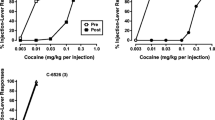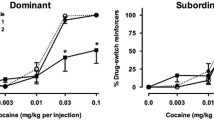Abstract
Rationale
Studies in laboratory animals have demonstrated an influence of environmentally derived stress and enrichment on the reinforcing effects of stimulants.
Objective
To characterize the effects of acute exposure to ethologically valid environmental stimuli on the reinforcing strength of cocaine relative to food in socially housed monkeys.
Materials and methods
Choice between cocaine and food was assessed in subsets of 16 socially housed (4/pen) male cynomolgus monkeys immediately after the following manipulations: (1) treats placed in home cage, (2) a 10-min exposure to a rubber snake, or (3) 3 to 7 days of living in a larger environment without cage mates.
Results
Placing treats in the home cage shifted the cocaine dose–response curve to the left in five monkeys tested and to the right in 4 of 12 animals. The rubber snake significantly shifted the cocaine choice curve to the left in dominant monkeys. Exposure to an enlarged environment decreased cocaine choice in 9 of 15 monkeys; this effect was transient and not related to social rank. Repeated testing did not affect cocaine choice.
Conclusions
Brief exposure to environmental events hypothesized to be stressors or enrichment altered cocaine choice, although not all individuals were affected and the effects were transient. Importantly, the data suggest that implementing positive changes in the environment produced effects that are clinically desirable. Understanding the behavioral and neurobiological mechanisms mediating sensitivity to environmental events in socially housed animals will lead to better treatment strategies for drug addiction.



Similar content being viewed by others
References
Bardo MT, Donohew RL, Harrington NG (1996) Psychobiology of novelty seeking and drug seeking behavior. Behav Brain Res 77:23–43
Botelho S, Estanislau C, Morato S (2007) Effects of under- and overcrowding on exploratory behavior in the elevated plus-maze. Behav Processes 74:357–362
Bowling SL, Rowlett JK, Bardo MT (1993) The effect of environmental enrichment on amphetamine-stimulated locomotor activity, dopamine synthesis and dopamine release. Neuropsychopharmacology 32:885–893
Brown KJ, Grunberg NE (1996) Effects of environmental conditions on food consumption in female and male rats. Physiol Behav 60:293–297
Crockett CM, Bowers CL, Shimoji M, Leu M, Bowden DM, Sackett GP (1995) Behavioral responses of longtailed macaques to different cage sizes and common laboratory experiences. J Comp Psychol 109:368–383
Czoty PW, Morgan D, Shannon EE, Gage HD, Nader MA (2004) Characterization of dopamine D1 and D2 receptor function in socially housed cynomolgus monkeys self-administering cocaine. Psychopharmacology 174:381–388
Czoty PW, McCabe C, Nader MA (2005) Assessment of the reinforcing strength of cocaine in socially housed monkeys using a choice procedure. J Pharmacol Exp Ther 312:96–102
Czoty PW, Gould RW, Nader MA (2009) Relationship between social rank and cortisol and testosterone concentrations in male cynomolgus monkeys (Macaca fasciculars). J Neuroendocrinol 21:68–76
Czoty PW, Gage HD, Nader MA (2010) Differences in D2 dopamine receptor availability and reaction to novelty in socially housed male monkeys during abstinence from cocaine. Psychopharmacology 208:585–592
Draper WA, Bernstein WS (1963) Stereotyped behaviour and cage size. Percept Mot Ski 16:231–234
Drgon T, Zhang PW, Johnson C, Walther D, Hess J, Nino M, Uhl GR (2010) Genome wide association for addiction: replicated results and comparisons of two analytic approaches. PLoS One 5(1):e8832
Gadek-Michalska A, Bugajski J (2003) Repeated handling, restraint, or chronic crowding impair the hypothalamic–pituitary–adrenocortical response to acute restraint stress. J Physiol Pharmacol 54:449–459
Goeders NE (2002) The HPA axis and cocaine reinforcement. Psychoneuroendocrinology 27:13–33
Green TA, Gehrke BJ, Bardo MT (2002) Environmental enrichment decreases intravenous amphetamine self-administration in rats: dose–response functions for fixed- and progressive-ratio schedules. Psychopharmacology 162:373–378
Hall FS, Humby T, Wilkinson LS, Robbins TW (1997) The effects of isolation-rearing of rats on behavioural responses to food and environmental novelty. Physiol Behav 62:281–290
Kalin NH, Shelton SE, Davidson RJ, Kelley AE (2001) The primate amygdala mediates acute fear but not the behavioral and physiological components of anxious temperament. J Neurosci 21:2067–2074
Kaplan JR, Manuck SB, Clarkson TB, Lusso FM, Taub DM (1982) Social status, environment, and atherosclerosis in cynomolgus monkeys. Arteriosclerosis 2:359–368
Kaplan JR, Manuck SB, Adams MR, Weingand KW, Clarkson TB (1987) Inhibition of coronary atherosclerosis by propranolol in behaviorally predisposed monkeys fed an atherogenic diet. Circulation 76:1364–1372
Kaufman BM, Pouliot AL, Tiefenbacher S, Novak MA (2004) Short and long-term effects of a substantial change in cage size on individually housed, adult male rhesus monkeys (Macaca mulata). Appl Anim Behav Sci 88:319–330
Kitchen AM, Martin AA (1996) The effects of cage size and complexity on the behaviour anf captive common marmosets, Callithrix jacchus jacchus. Lab Anim 30:317–326
Line SW, Morgan KN, Markowitz H, Strong S (1989) Influence of cage size on heart rate and behavior in rhesus monkeys. Am J Vet Res 50:1523–1526
Miczek KA, Yap JJ, Covington HE 3rd (2008) Social stress, therapeutics and drug abuse: preclinical models of escalated and depressed intake. Pharmacol Ther 120:102–128
Morgan D, Grant KA, Prioleau OA, Nader SH, Kaplan JR, Nader MA (2000) Predictors of social status in cynomolgus monkeys (Macaca fascicularis) after group formation. Am J Primatol 52:115–131
Morgan D, Grant KA, Gage HD, Mach RH, Kaplan JR, Prioleau O, Nader SH, Buchheimer N, Ehrenkaufer RL, Nader MA (2002) Social dominance in monkeys: dopamine D2 receptors and cocaine self-administration. Nat Neurosci 5:169–174
Nader MA, Czoty PW (2005) PET imaging studies of dopamine D2 receptors in monkey models of cocaine abuse: genetic predisposition versus environmental modulation. Am J Psychiatry 162:1473–1482
Negus SS (2003) Rapid assessment of choice between cocaine and food in rhesus monkeys: effects of environmental manipulations and treatment with d-amphetamine and flupenthixol. Neuropsychopharmacology 28:919–931
Nelson EE, Shelton SE, Kalin NH (2003) Individual differences in the responses of naïve rhesus monkeys to snakes. Emotion 3:3–11
O’Brien MS, Anthony JC (2005) Risk of becoming cocaine dependent: epidemiological estimates for the United States, 2000-2001. Neuropsychopharmacology 30:1006–1018
Paulk HH, Dienske H, Ribbens LG (1977) Abnormal behavior in relation to cage size in rhesus monkeys. J Abnorm Psychol 86:87–92
Prather MD, Lavenex P, Mauldin-Jourdain ML, Mason WA, Capitanio JP, Mendoza SP, Amaral DG (2001) Increased social fear and decreased fear of objects in monkeys with neonatal amygdala lesions. Neuroscience 106:653–658
Sapolsky RM (2005) The influence of social hierarchy on primate health. Science 308:648–652
Stairs DJ, Bardo MT (2009) Neurobehavioral effects of environmental enrichment and drug abuse vulnerability. Pharmacol Biochem Behav 92:377–382
Thiel KJ, Sanabria F, Pentkowski NS, Neisewander JL (2009) Anti-craving effects of environmental enrichment. Int J Neuropsychopharmacol 12:1151–1156
Yuferov V, Levran O, Proudnikov D, Nielsen DA, Kreek MJ (2010) Search for genetic markers and functional variants involved in the development of opiate and cocaine addiction and treatment. Ann N Y Acad Sci 1187:184–207
Acknowledgements
This research was supported by the National Institute on Drug Abuse grant R37 DA10584. The authors report no conflict of interest and would like to acknowledge the technical assistance of Michael Coller, Michelle Icenhower and Nicholas Garrett and the helpful contributions to the experimental design provided by Dr. Jay R. Kaplan.
Author information
Authors and Affiliations
Corresponding author
Rights and permissions
About this article
Cite this article
Czoty, P.W., Nader, M.A. Individual differences in the effects of environmental stimuli on cocaine choice in socially housed male cynomolgus monkeys. Psychopharmacology 224, 69–79 (2012). https://doi.org/10.1007/s00213-011-2562-3
Received:
Accepted:
Published:
Issue Date:
DOI: https://doi.org/10.1007/s00213-011-2562-3




